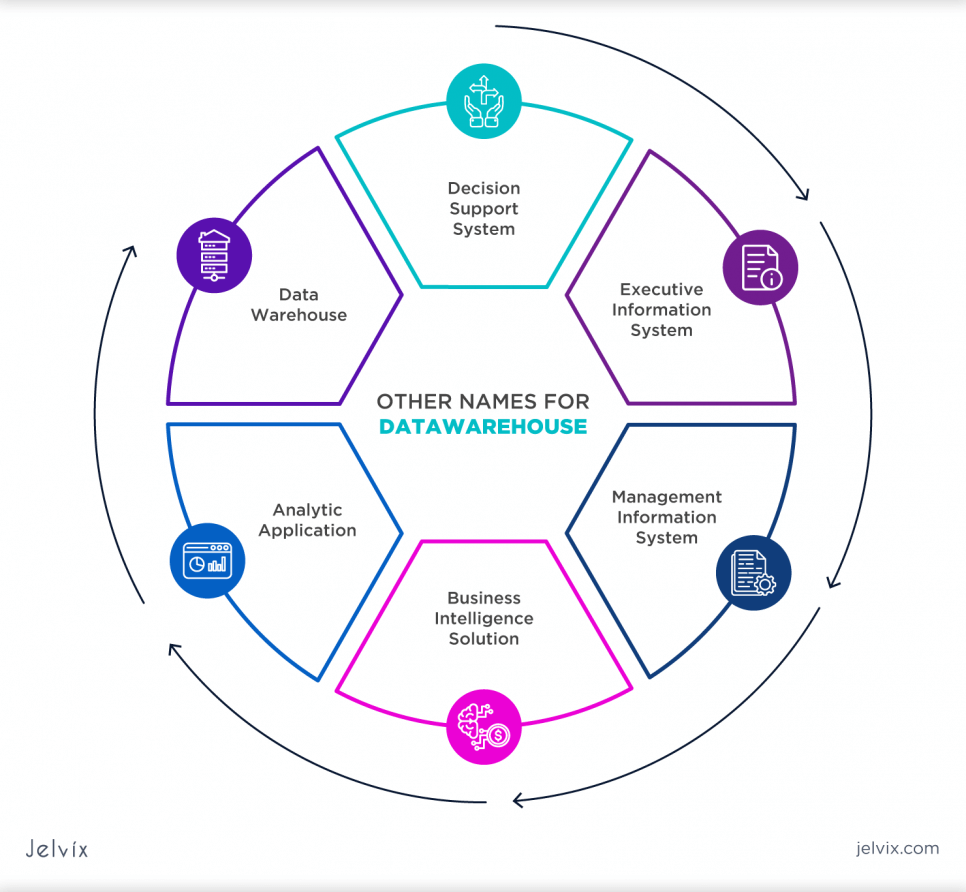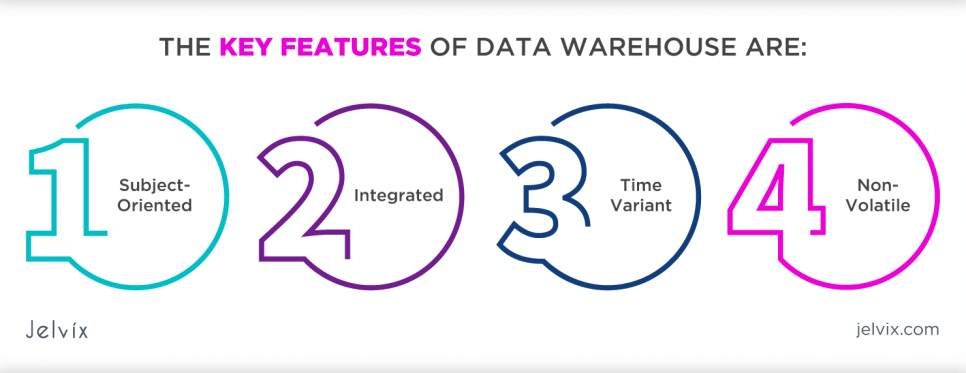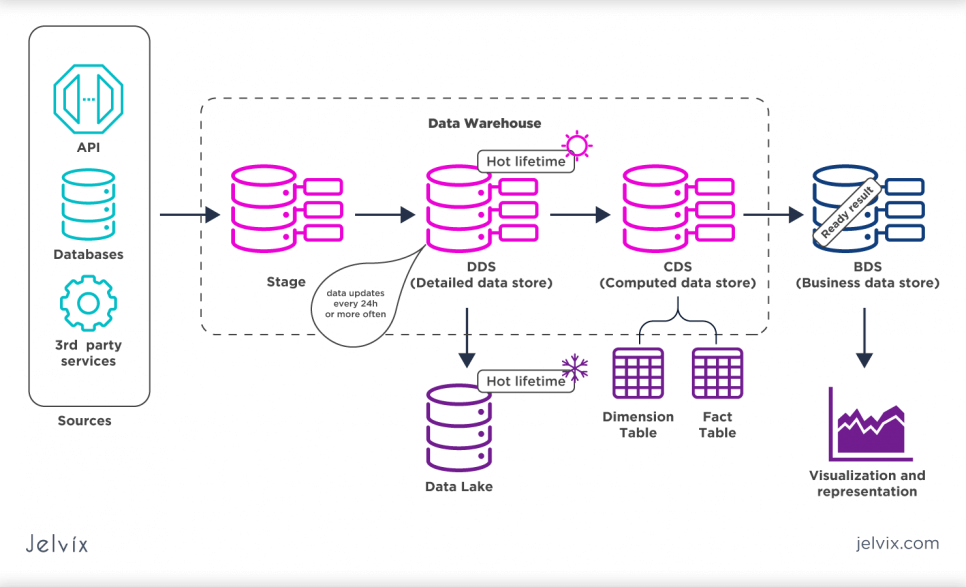The more data in the cloud a company has, the more effective it will attract new customers, develop growth strategies, and strengthen its position in the market.
To store data, special kinds of storage are used, such as Cloud Data Warehouse. How does DWH differ from simple databases, how are such solutions used, which businesses are they suitable for, and why should your company have a Cloud-hosted Database? You will find the answers to these and other interesting questions below.
What Is a Cloud-based Data Warehouse: Definition and Advantages
The persistent need for a corporate Cloud-based Data Warehouse appeared back in the 90s of the 20th century. During that period, information systems began to be actively used in the business environment. Companies used them to monitor many performance indicators, providing the ability to instantly respond to their changes. Each of the applications locally automated the process of manufacturing or selling goods, performing accounting calculations, and conducting banking operations, making it possible to draw up analytics.
The main difficulties at this stage consisted of different working schemes of various systems, which led to discrepancies in the information. It was not possible to obtain consolidated data to create a complete picture from individual application systems.
The solution to this problem is a corporate Cloud-based Data Warehouse or, in other words, DWH. The concept was first introduced back in 1988 by IBM researchers named Barry Devlin and Paul Murphy. It is a domain-specific database that allows you to automatically generate consolidated reports and perform business intelligence integration. Thanks to it, the user gets the opportunity to make the right management decisions timely based on holistic information.
So how does a DWH differ from regular databases? And why does it attract so much attention from business analysts? Does your business actually need it? Keep reading to find out more about this and other questions.
Cloud Data solutions are most often used for data storage. Database Cloud advantages are the following:
- Support and scalability. No need to allocate space for servers and connect new ones in case of load growth. Cloud storage usually scales automatically;
- Performance. Cloud Data solutions are faster than traditional ones and automatically redistribute the load;
- Access to data. To get into Cloud storage, you do not need to install a server on your computer. It is enough to open a browser and log into the Cloud. SQL query can be done even from a smartphone.
Database Cloud advantages for ill people
- Medical Informatics: the scientific field that defines what kind of data is valuable and required for practice in healthcare, education, and study;
- Chronic Disease Management: be aware of not only the patient’s personal history of illness but how other people with similar diseases react to a particular therapy or treatment instructions;
- Constant Feedback Loop: data storage is constantly updated when new information appears.
Database Cloud advantages for the population
- Decide if screening initiatives and protective care actions are operating well;
- Concentrate on typical population groups and/or providers to control the management of the chronic disease;
- Support bio-surveillance efforts through the monitoring of diagnoses and antibiotic prescribing;
- Retrospective analysis that is focused on population:
– Are the demographics of the health center or the community changing?
-Are the patients moving or being replaced?
-Are there environmental aspects connected to a specific geographic spot that influences the patient population?
Database Cloud advantages for the provider
- Identify the best techniques in the treatment of chronic disease:
- Which providers have patients with more profitable outcomes?
- Which providers may require aid based on the less-than-suitable outcomes of their patients?
- Which providers are reaching clinical goals?
- Which patients are adhering to therapy instructions and medication observance?
- Determine existing possibilities to enhance care and outcomes;
- Encourage the “collegial competition” that many providers are engaged in when all data and information are evident. As a result, the general outcomes boost;
- Help meet the purposes of pay-for-performance initiatives.
Read more about the most common software development strategies and take a look at their benefits and drawbacks.
Database Cloud advantages for the organization
- Use the information to acquire knowledge regarding an organization, how it is functioning, and how to enhance the decision-making processes.
- Set measures to define how unique centers within an HCCN or PCA are working and set standards against which they can be estimated.
- Plan for functional necessities such as personal space, supplies, and other human resources.
- Deliver insight for financial modeling.
- Present performance information when arranging refund levels.
- Improve reporting options for internal management goals as well as for grant and other regulatory essentials.
- Deliver information of use to make information organizations better.
- Help fiscal management and projections.
The main examples of Data Warehouses are Amazon Redshift, as well as Google BigQuery, and Azure. They have different costs, performances, ecosystems, and support.
The unified data storage provides:
- Instant access to the required data. In a large company with a complex and developed structure, a specific department is responsible for storing certain information. And in order to gain access to it, approvals, permissions, and accesses are required. It will be necessary to additionally request passwords. All this is a waste of time and effort, which in many cases is a decisive factor. With Data Cloud solutions, all the information you need is right in your hands. You just need to pull out the necessary statistics from there.
- Guaranteed security of information. It is not possible to “lose” data in DWH. It is initially saved in the most convenient format, including aggregated values. If the usual base on the server cannot physically place 10-year archives, then this is the norm for DWH. The user receives information about the company’s activities for any period.
- Stability of business systems functioning. Analysts will work only with Cloud Data Warehouse solutions, without interfering with the work of other databases, which could lead to problems in their work and jeopardize the work of the entire department or division.
On the basis of Cloud Data Warehousing, individual solutions for large amounts of data are also created. Many developers create personal boxed and Cloud projects specifically for such tasks.
The Structure of Cloud Data Warehouse
Cloud Data Warehousing consists of several levels:
- Area of primary data collection. Information from different departments of the company and the database flows here.
- Nucleus. All disparate information received by DWH is reduced to the necessary structures and keys. It is this key component of Cloud-based Data storage that ensures the integrity and completeness of the data.
- Showcases of analytics. The data is converted into arrays that are convenient to use for solving specific problems. Such showcases can be primary (help to solve relatively simple tasks) and secondary (for complex analytical reports and non-standard tasks).
- Service layer. Responsible for managing the three previous levels. Provides data monitoring and prompt troubleshooting.
Cloud Hosted Database: Corporate Storage vs. Regular Databases
Businesses became actively interested in corporate storage at the end of the last century. The storages were implemented by businessmen to raise the speed of reaction to changes, as well as keep an eye on performance indicators and make the processes automated. Various applications matched different processes: some of them were utilized to conduct financial transactions, while others were used for coordinating supply chains. And still, other applications helped to diagnose the performance of sales.
However, this method caused the separate storing of key business data. Companies wanted to find a perfect solution that would let them analyze the full information, but not data from separate systems.
To find a solution, a special tool was finally created – a corporate data warehouse, or Data Warehouse. In fact, DWH means a domain-specific database that combines core business information and permits automation of the process of consolidating reports.
Cloud Data Warehousing is suitable corporate storage that includes archived data taken from multiple sources, such as systems, departments, etc. The purpose of Data Cloud solutions is to provide the user (the company and its key persons) with the knowledge to choose the key to business management based on comprehensive information. DWH means more than just a usual database. Cloud Data Warehouse firms differ from regular databases used in business with such purposes:
Types and sources of data
Conventional databases store data from specific company information systems. For example, in the database of the HR department, we will see information about employees, but there will be no data on deliveries. Data Warehouse Cloud solutions are built on a different principle: such a corporate repository consolidates information from all departments of the company – from sales statistics to information about employees.
Data volume
Traditional databases are operated to keep only up-to-date data- it is not logical to store this information for a few years of the enterprise’s operation in it. In Cloud-based Data storage, on the contrary, historical data and archival information are collected. For example, by looking at the Cloud Data Warehouse architecture, you can find out the data concerning all transactions over the past years.
Place in business processes
Originally, the information takes place in ordinary databases and goes to DWH. In other words, the best Cloud Data Warehouse always features the newest versions of the data.
What KPIs Should We Measure?
Key Performance Indicators are the main criteria that decision-makers can utilize to measure how well the healthcare enterprise performs in medical and financial areas. Besides an exact understanding of the operations in your organization, formulating KPIs demands clear goals and performance essentials for each process. Quantitative and qualitative estimations of process outcomes must then match organizational goals and serve as the basis for adapting strategies and resources. Such purposes should be SMART. This abbreviation means Specific, Measurable, Achievable, Realistic, and Timely.
The list of important KPIs includes the following:
- The index of waiting (100% Scheduled, 100% Open Access, Hybrid);
- How long the visit last;
- How long the procedure takes;
- Cancellation rates;
- Pharmacy days in goods and out-of-stock rate;
- Stock utilization and turnover;
- Lab, Radiology, Consult utilization and report reversal periods;
- The price for employees;
- Staff turnover;
- Sick, PTO, O/T rates, and costs. This indicator includes relationship (for instance O/T related to Sick and PTO);
- Budget variations;
- Revenue generation/collection by department/provider;
- The service fee.
Planning Cloud-based Data Storage
- Scope of Participants
-Which organizations will participate?
-How will they interact?
- Governance
-Who will provide oversight for the project?
-Who will govern the operation?
-Who will prioritize query requests?
-Who will set targets?
-Who will monitor compliance?
- Cost
-How much will it cost to implement?
-How much will it cost to operate?
-How will costs be allocated amongst participating organizations?
- Resource Allocation
-Who will build it?
-Who will operate it?
- Sustainability
-How will the value of the data be estimated to explain ongoing funding?
How to Create the Best Cloud Data Warehouse
When creating the best Cloud Data Warehouse, you need to take into account all the complexities. The main problem is the design of pipelines. You need to set up the transfer of data from all sources to single storage. During it, you will have to deal with imperfect APIs, upload restrictions, or data parsing. You can write all the connections yourself or use ready-made solutions (for example, Owox, Alooma, Blendo). For those who work with a large amount of information, it is better to write your scripts that will synchronize data every day.
A small business without a DBA should use a pipeline platform. Its cost depends on the amount of information and the number of connections.
The second difficulty is data quality. The data transfer may not generate an error. But at the same time, the information may be incomplete (due to limitations in the API). There is also a risk of errors during further parsing of variables (for example, there will be problems with encoding data from 1C).
The next step after creating the repository is the choice of tools for developing the frontend part. Business needs to see charts, slices, comparisons, and dynamics.
The development of data analytics in the company quickly gives a noticeable result. Having all the necessary data, it is easier to optimize advertising campaigns, conduct A / B tests, and work with product hypotheses. You can find more related information in W. H. Inmon’s “Building the Data Warehouse”. This practical guide was first published in 1990.
Diagram of data warehouse architecture
- The data comes into Data Warehouse from various sources. For example, API, databases, and third-party components.
- Data Warehouse itself consists of 3 schemes: Stage- for intermediate storage of data from sources, DDS- a stable layer for storing detailed data, and SDS- a layer that contains new data obtained during data processing from DDS.
- Data in DDS is processed quite often (from less than every 24 hours and up to 1-2 hours).
- The DDS layer is used for online access to data, but for longer storage, there is Data Lake.
- SDS contains Dimension Tables and Fact Tables.
- BDS scheme, which may not exist permanently (maybe abstract). In fact, it contains ready-made results for visualization and demonstration.
Why Cloud Data Warehouse Services Are an Effective Analytics Tool
DWH and business analysts are transforming company management from art to science. Having the results of measurements for hundreds of indicators at hand, you can put forward hypotheses and set up experiments. The right decisions are easily confirmed by objective figures that analysts get from DWH.
Optimal management decisions are not always profit maximization. It is also the growth of new production capacities, minimizing the negative impact on the environment, a decent quality of life for employees, customer loyalty, and business stability in the long term. All of these seemingly complex and ephemeral metrics can be analyzed using BI and data from DWH.
Without DWH and analysts, business management turns into a blind ride on ice – perhaps with a certain skill you will get where you need to, but there are still many more chances to fly into a snowdrift or a pillar.
Corporate storage plays the role of a large Data Warehouse. So, let’s get a panoramic view of the opportunities the companies are organizing DWHs in pursuit of.
Prompt access to the necessary information
The bigger the business is, the more departments it includes. And each of these divisions generates its data streams. And the tougher it is for an analyst to get quick access to the necessary information. Just think about it: to investigate one issue, you need to demand access and permissions to different databases from various departments. And it will take longer for the analyst to get all the information needed. DWH solves this problem by providing you with all the information you need in a short period of time.
Long-term data reservation
Normally, conventional databases are not used to keep information for the last ten years of a company’s function. But for DWH, such a period is an absolute norm. At the same time, all data is kept in the perfect format, including amassed values.
Eliminate the impact of business intelligence on other processes
If the analytical department suddenly needs more data and specialists unload it from DWH, the load on the storage will not affect the operation of other information systems and business applications.
Why Jelvix among Other Software Development Companies?
At Jelvix, we help both global businesses and growing startups deliver custom software engineering services. With 11 years of deep expertise, our award-winning software development company has delivered solutions and processes pitch-ready, investment-worthy, and user-focused.
For example, our team of custom software development engineers presented a solution for a UK-based company that provides secure storage for personal files. As a result, outstanding iOS and Android apps have created that offer completely secure storage, sharing, and immediate access to documents. During the cooperation, we helped the client transform their business idea into a visually appealing and market-ready product including such technologies:
- iOS native development
- Android development
- Back-end development
- Front-end development
- UI/UX design
- QA automation
- Architecture (MVP, Angular8).
Continue reading the full case study here.
Conclusion
Up-to-date business intelligence instruments, coupled with DWH capabilities. BI tools allow you to make management decisions with guaranteed results. Thanks to the effective analysis of large data sets, company management can also put forward hypotheses based on real business indicators and test them.
To sum up, the Cloud Data Warehouse solution helps to solve specific applied tasks (for example, increase profits and reduce costs). It also builds a company development strategy based on a data-driven approach.
FAQs
What is a cloud data warehouse?
A cloud data warehouse is an excerpt of any company’s data that is often taken from some sources in order to streamline analysis, reporting, and strategic decision-making. A cloud data warehouse features only alpha-numeric data, not documents or other content.
With the help of dimensional modeling techniques, it is easier to obtain the information from Data Warehouse when it is in the database. Such techniques also help query data faster, as a result, the business performance improves. While dimensional tables can feature more columns without changing business intelligence apps.
What is the difference between a data warehouse and a cloud?
The term data warehouse differs from the regular cloud in several ways:
- type and source of data that will be stored;
- the amount of information stored;
- role and place in business processes.
Is Google cloud a data warehouse?
No, it is not the same. The thing is that data warehouse is operated to analyze and report-structured and semi-structured information from various sources.
Is Snowflake a cloud data warehouse?
The term Snowflake is a service similar to a data warehouse, but it works on multiple clouds.
Need a qualified team of developers?
Unlock new business opportunities with the first-rate dedicated development team.














